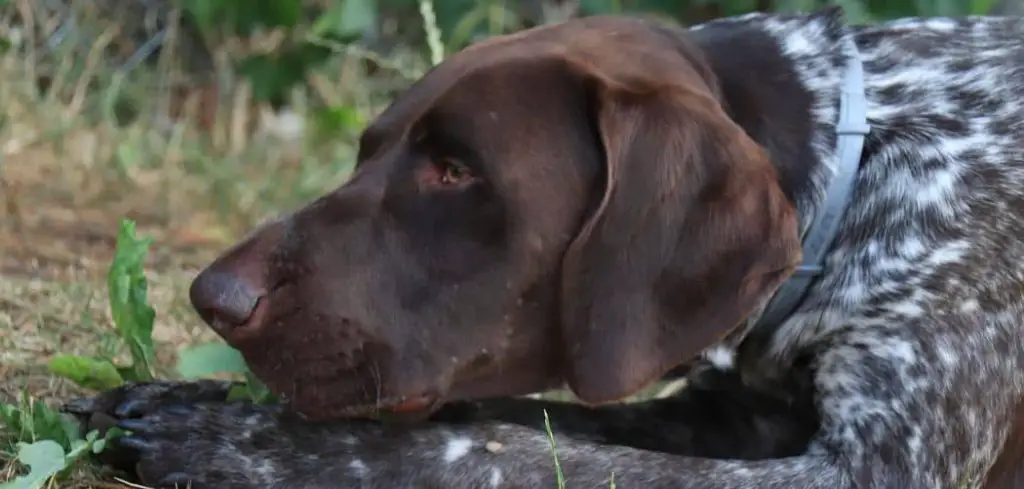If your dog is throwing up and not drinking water, it’s a sign that something could be seriously wrong. Occasional vomiting might be common for dogs, but when it is paired with refusal to drink water, it becomes a red flag.
We outline why dog throwing up and not drinking water happens, what it means, and when to seek veterinary attention.
Here’s Why Dog Throwing Up and Not Drinking Water Happens
When a dog throws up, they lose fluids and stomach acids. Normally, dogs will instinctively drink water to rehydrate. However, if a dog is not drinking water after vomiting, it may indicate pain, nausea, weakness, or a more serious health issue. This combination can quickly lead to dehydration, electrolyte imbalance, and worsening of the underlying problem.
It’s especially important to monitor this behavior in puppies, senior dogs, or dogs with pre-existing health conditions, as they are more vulnerable to the effects of fluid loss.

Common Causes of Dog Throwing Up and Not Drinking Water
1. Gastrointestinal Illness
One of the most common reasons a dog is throwing up and not drinking water is due to gastrointestinal (GI) upset. This can be caused by:
Viral or bacterial infections
Intestinal parasites
Ingestion of spoiled food
Inflammatory bowel disease
These illnesses can cause inflammation of the stomach and intestines, leading to vomiting.
If the vomiting is persistent, your dog may feel too nauseous or weak to drink. This can escalate into a dangerous cycle of dehydration and worsening symptoms.
If your dog vomits more than once and refuses to drink water, this should prompt immediate veterinary evaluation.
Related: Dog throwing up and drooling (Explained)
2. Ingesting a Foreign Object or Toxin
Dogs are curious creatures and often chew or swallow things they shouldn’t—like toys, bones, fabric, or garbage.
If your dog is throwing up and not drinking water, it might be due to an intestinal blockage or toxicity.
A swallowed object can obstruct the gastrointestinal tract, causing repeated vomiting and discomfort.
Similarly, toxic substances (like chocolate, xylitol, human medications, or household cleaners) can irritate the stomach lining or affect vital organs, making the dog nauseous and lethargic.
Other symptoms may include:
Drooling
Shaking
Pale gums
Collapse
These are emergency situations—if you suspect ingestion of a foreign object or poison, seek veterinary help immediately.
3. Pancreatitis
Pancreatitis is inflammation of the pancreas, often caused by eating fatty or rich foods. It’s a serious condition that may lead to:
Severe vomiting
Abdominal pain
Lethargy
Lack of appetite
Not drinking water
A dog with pancreatitis often avoids both food and water because eating or drinking makes the pain worse.
Left untreated, this can result in life-threatening dehydration and systemic infection.
This condition requires prompt medical treatment, including IV fluids, pain relief, and supportive care.
4. Kidney Disease
Dogs suffering from kidney disease may vomit frequently due to the buildup of toxins in the body.
Nausea and general malaise cause them to avoid eating or drinking. In early stages, dogs may still drink more water to flush toxins.
But in advanced cases, the feeling of sickness becomes so intense that they stop drinking altogether.
Symptoms of kidney issues include:
Vomiting
Weight loss
Bad breath (ammonia-like smell)
Pale gums
Lethargy
If your dog is throwing up and not drinking water consistently, especially if they are older, kidney disease could be a likely culprit.
5. Heatstroke or Overheating
Dogs can overheat quickly, especially in warm climates or after excessive physical activity.
A dog throwing up and not drinking water could be showing signs of heatstroke, a life-threatening condition.
Additional signs include:
Heavy panting
Bright red tongue or gums
Wobbliness
Collapse
Ironically, dogs experiencing heatstroke may avoid drinking even though they desperately need hydration. Immediate cooling and emergency care is vital in such cases.
6. Parvovirus (Puppies and Unvaccinated Dogs)
Canine parvovirus (parvo) is a highly contagious viral disease that primarily affects puppies and unvaccinated dogs.
It causes severe vomiting, diarrhea, lethargy, and refusal to eat or drink.
Parvo progresses rapidly and is often fatal without aggressive treatment.
A puppy throwing up and not drinking water should be rushed to a veterinarian right away.
Related: Dog throwing up and coughing (Explained)
7. Motion Sickness or Anxiety
Some dogs vomit due to motion sickness or anxiety, such as during car rides or stressful events.
If the stressor is significant enough, it may also lead to a loss of appetite and reluctance to drink water.
While less dangerous than medical causes, ongoing vomiting from stress still requires attention to avoid dehydration and address the root cause.
Symptoms to Watch Alongside Vomiting and Not Drinking Water
When your dog is throwing up and not drinking water, other symptoms can help pinpoint the underlying cause. Watch for:
Diarrhea
Lethargy or weakness
Dry nose or sticky gums (signs of dehydration)
Loss of appetite
Panting or restlessness
Abdominal bloating or pain
The more symptoms your dog displays, the more serious the condition may be.
Related: Dog throwing up and licking floor (Explained)
How to Help: What to Do If Your Dog Is Throwing Up and Not Drinking Water
If your dog throws up once but otherwise seems fine, monitor them closely. However, if vomiting persists and they refuse water, here’s what you can do:
Step 1: Check for Dehydration
Gently lift the skin on the back of your dog’s neck. If it doesn’t snap back quickly, your dog may be dehydrated.
Also look for:
Dry or sticky gums
Sunken eyes
Weakness or collapse
These are signs that veterinary attention is needed urgently.
Step 2: Remove Food and Monitor
Temporarily withhold food for 6–12 hours to let the stomach settle.
Continue to offer small amounts of water, or ice chips if they refuse to drink.
If vomiting stops, you can slowly reintroduce a bland diet (like boiled chicken and rice). But if your dog still won’t drink water after several hours, go to the vet.
Step 3: Never Force Water
Do not attempt to force water down your dog’s throat. This can cause choking or worsen nausea.
Instead, offer water in small amounts frequently, or try ice cubes to encourage licking.
When to See a Veterinarian Immediately
Seek urgent veterinary care if:
Your dog is throwing up repeatedly
Your dog is not drinking water for more than 12 hours
Vomit contains blood or appears like coffee grounds
There’s accompanying diarrhea, lethargy, or collapse
You suspect poisoning or foreign object ingestion
Your dog is very young, very old, or has a pre-existing condition
Dehydration and vomiting can escalate quickly. Early intervention greatly increases the chance of full recovery.
Key Takeaway
Vomiting in dogs may not always be serious—but when your dog is throwing up and not drinking water, it should never be ignored.
This combination often signals more than just a mild upset stomach.
It can be due to infections, poisoning, gastrointestinal issues, heatstroke, or serious systemic diseases like kidney failure or pancreatitis.
Always monitor your dog’s behavior, hydration status, and overall condition closely.
If vomiting is persistent and your dog refuses water, consult your veterinarian as soon as possible.
Timely diagnosis and treatment can make all the difference in your dog’s health and recovery.
